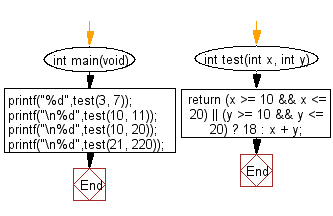C Exercises: Compute the sum of the two specified integers. If one of the given integer value is in the range 10..20 inclusive return 18
22. Sum with Special Range Override
Write a C program to compute the sum of the two given integers. Return 18 if one of the integer values given is in the range 10..20 inclusive.
C Code:
#include <stdio.h> // Include standard input/output library
#include <stdlib.h> // Include standard library for additional functions
// Function declaration for 'test' with two integer parameters 'x' and 'y'
int test(int x, int y);
int main(void){
// Print the result of calling 'test' with different integer values and format the output
printf("%d",test(3, 7));
printf("\n%d",test(10, 11));
printf("\n%d",test(10, 20));
printf("\n%d",test(21, 220));
}
// Function definition for 'test'
int test(int x, int y)
{
// Check if either 'x' or 'y' is within the range of 10 to 20 (inclusive)
if (x >= 10 && x <= 20 || y >= 10 && y <= 20) {
return 18; // If the condition is true, return 18
} else {
return x + y; // If the condition is false, return the sum of 'x' and 'y'
}
}
Sample Output:
10 18 18 241
Explanation:
int test(int x, int y) {
return (x >= 10 && x <= 20) || (y >= 10 && y <= 20) ? 18 : x + y;
}
The function takes two integer arguments x and y, and returns 18 if either x or y is between 10 and 20 (inclusive). Otherwise, it returns the sum of x and y.
Time complexity and space complexity:
The time complexity of this function is O(1) because it only performs a constant number of operations, regardless of the input size.
The space complexity of this function is O(1) because it only uses a constant amount of memory to store the input arguments and the return value.
Pictorial Presentation:
Flowchart:

For more Practice: Solve these Related Problems:
- Write a C program to compute the sum of two integers, but return 25 if one of the integers is between 15 and 25 inclusive.
- Write a C program that adds two numbers and returns a fixed value if their sum is within a given range.
- Write a C program to sum two integers, but return triple the sum if one is in the range 5..15.
- Write a C program that computes the sum of two numbers and returns a constant if either number is within a specific range.
Go to:
PREV : Near Multiple of 10 Check.
NEXT : Three Integer Sum Match.
C Programming Code Editor:
What is the difficulty level of this exercise?
Test your Programming skills with w3resource's quiz.
